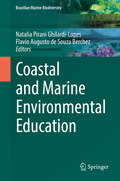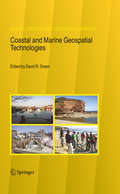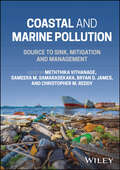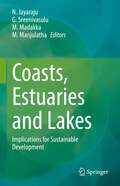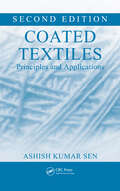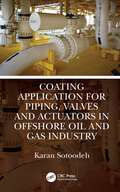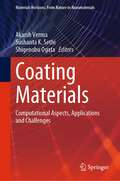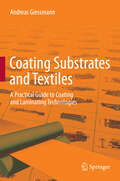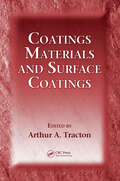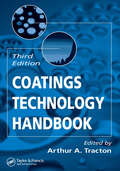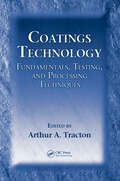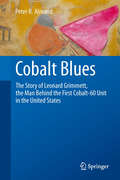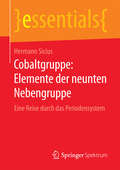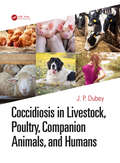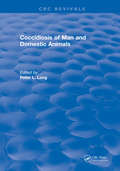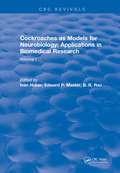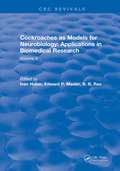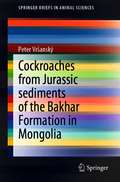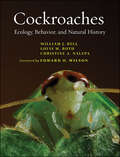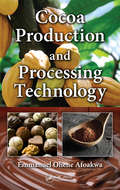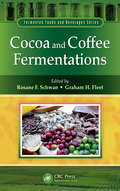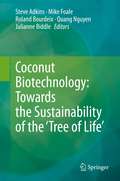- Table View
- List View
Coastal and Marine Environmental Education (Brazilian Marine Biodiversity)
by Natalia Pirani Ghilardi-Lopes Flavio Augusto BerchezThis book provides a broad overview of how the promotion of ocean and coastal literacy is being planned, applied and evaluated in Brazil, a country of continental dimensions with a great diversity of cultural, educational and social realities. It discusses a range of target groups, from children to adults; formal and informal strategies; and various promoting players, such as groups/institutions. Researchers representing Brazilian academic institutions and NGOs share their environmental education (EE) experiences in Brazil and describe the main concerns regarding the marine and coastal environments as well as how they are addressing these concerns in their EE projects. This book is of interest to anyone who is looking for ways of designing and implementing EE activities with a robust theoretical background in different socio-cultural scenarios.
Coastal and Marine Geospatial Technologies (Coastal Systems and Continental Margins #13)
by D. R. GreenThis international collection of papers represents a selected and up-to-date overview of some of the main areas of research into the application of the geospatial technologies, including geographical information systems (GIS), remote sensing, digital mapping, global positioning systems (GPS), databases, Internet technology, and mobile field-data collection and mapping, to coastal and marine environments around the World. Aimed at the researcher, editor, practitioner and student, this volume seeks to expand the available literature in a rapidly expanding and evolving area, namely the coastal and marine environment. The book comes at a time when there is growing concern about global warming, climate change, and sea level rise, all of which will have an impact upon coastal areas. These geospatial technologies offer the possibility to gather unique environmental data to study the coast, to process the data into information, to visualise data and landscapes, to gather data in the field, and to involve stakeholders in coastal management amongst other things. Considerable potential now exists to raise awareness, to educate and to embrace these technologies as one way to promote greater knowledge and understanding of our marine and coastal environments.
Coastal and Marine Pollution: Source to Sink, Mitigation and Management
by Meththika Vithanage Sameera M. Samarasekara Bryan D. James Christopher M. ReddyA multi-faceted analysis of how to preserve the long-term health of the world’s largest ecosystem In Coastal and Marine Pollution: Source to Sink, Mitigation and Management, a team of distinguished researchers delivers a comprehensive overview of the factors and stakeholders impacting — and impacted by — coastal and marine pollution. The book offers broad and up-to-date coverage of the topic, serving as a valuable reference for professionals and researchers working in the field. The authors integrate and compare the two main sources of marine and coastal pollution: chronic, long-term, low-level pollution as well as occasional, accidental, disaster-related pollution. They bridge the gap between theory and real-world action, offering best practices for monitoring and preventing pollution, as well as efficient governance and disaster management strategies. Readers will find: A thorough overview of the global state of coastal and marine pollutionComprehensive explorations of different types of pollution, including their sources, distribution, and impacts on the biophysical environmentPractical discussions of pollution monitoring methods, including ecotoxicological approaches and proven strategies for managing coastal and marine pollutionA critical assessment of policy and governance issues, including public awareness and disaster response strategies Perfect for researchers and professionals in the fields of marine biology, ecology, and environmental protection, Coastal and Marine Pollution will also benefit professionals working in the shipping, fishing, deep-sea mining and drilling industries, as well as those affiliated with governmental and non-governmental organizations.
Coasts, Estuaries and Lakes: Implications for Sustainable Development
by N. Jayaraju G. Sreenivasulu M. Madakka M. ManjulathaThis volume discusses geological, biological and sustainability aspects of coastal, estuary and lake environments. It offers a comprehensive understanding of biotic, physico-chemical, sedimentological and socio-environmental factors associated with the sustainable development of these environments in areas vulnerable to climate change and other anthropogenic activities. The book is divided into several main sections, covering the geological and biological processes and dynamics of these environments, water quality and hydrological modeling, sediment characteristics, bio-indicators and ecological analysis, climate change impacts, geospatial applications, and sustainable development practices and scenarios. The book aims to be a useful resource for academics, scientists, coastal and marine practitioners, meteorologists, environmental consultants and computing experts working in the areas of earth and ocean sciences.
Coated Textiles: Principles and Applications, Second Edition
by Ashish Kumar SenInitially written to pull together scattered literature in polymer science and textile technology, the first edition of Coated Textiles: Principles and Applications became a gold standard resource in this field. Completely revised and updated, this second edition reflects not only the latest developments in the field, but also explores futur
Coating Application for Piping, Valves and Actuators in Offshore Oil and Gas Industry
by Karan SotoodehThis book looks at the applications of coating in piping, valves and actuators in the offshore oil and gas industry. Providing a key guide for professionals and students alike, it highlights specific coating standards within the industry, including ISO, NORSOK, SSPC and NACE. In the corrosive environment of a seawater setting, coatings to protect pipes, valves and actuators are essential. This book provides both the theory behind these coatings and practical applications, including case studies from multinational companies. It covers different offshore zones and their corrosivity level alongside the different types of external corrosion, such as stress cracking and hydrogen-induced stress cracking. The key coatings discussed are zinc-rich coatings, thermal spray zinc or aluminum, phenolic epoxy and passive fire protection, with a review of their defects and potential failures. The book also details the role of coating inspectors and explains how to diagnose faults. Case studies from companies such as Aker Solutions, Baker Hughes, Equinor and British Petroleum illustrate the wide range of industrial applications of coating technologies. This book is of interest to engineers and students in materials, coating, mechanical, piping or petroleum engineering.
Coating Materials: Computational Aspects, Applications and Challenges (Materials Horizons: From Nature to Nanomaterials)
by Akarsh Verma Shigenobu Ogata Sushanta K. SethiThis book comprehensively reviews assorted types of coatings, their applications, and various strategies employed by several scientists and researchers to fabricate them. Exclusively, the recent progress in computational strategies that are helpful to optimize the best suitable coating formulation before one goes for the real-time fabrication has been discussed in detail. And this book is also intended to shed light on the computational modeling techniques that are used in the characterization of various coating materials. It covers mechanisms, salient features, formulations, important aspects, and case studies of coatings utilized for various applications. The latest research in this area as well as possible avenues of future research is also highlighted to encourage the researchers.
Coating Substrates and Textiles: A Practical Guide to Coating and Laminating Technologies
by Andreas GiessmannThis book provides knowledge on the finishing of substrates with a functionalising coating, emphasizing on technical textiles. The spectrum of topics covers different substrates and coating materials, process engineering and equipment components as well as complex machinery. The reader is presented with an overview of the technical capabilities of substrate coating, enabling the practitioner to design and implement new products. Furthermore the author goes into detail on various air pollution control procedures and economic issues of asset valuation.
Coatings Materials and Surface Coatings
by Arthur A. TractonDrawing from the third edition of The Coatings Technology Handbook, this text provides a detailed analysis of the raw materials used in the coatings, adhesives, paints, and inks industries. Coatings Materials and Surface Coatings contains chapters covering the latest polymers, carbon resins, and high-temperature materials used for coatings, adhesiv
Coatings Technology Handbook
by Arthur A. TractonServing as an all-in-one guide to the entire field of coatings technology, this encyclopedic reference covers a diverse range of topics-including basic concepts, coating types, materials, processes, testing and applications-summarizing both the latest developments and standard coatings methods. Take advantage of the insights and experience of over
Coatings Technology: Fundamentals, Testing, and Processing Techniques
by Arthur A. TractonDrawn from the third edition of The Coatings Technology Handbook, this book focuses entirely on testing, experimental design, and strategies for selecting processing techniques in the coatings, adhesives, paints, and inks industries. Coatings Technology: Fundamentals, Testing, and Processing Techniques contains the latest coating and processing met
Cobalt Blues: The Story of Leonard Grimmett, the Man Behind the First Cobalt-60 Unit in the United States
by Peter R. AlmondFor the last half of the 20th century cobalt-60 units were the mainstay of radiation treatments for cancer. This book describes the development of the first cobalt -60 unit in the United States and the man behind it, Leonard Grimmett. Conceptually conceived before World War II it only became possible because of the development of nuclear reactors during the war. The initial idea was to replace the radium in the contemporary units of the time with cobalt-60, but with the realization that the reactors could produce much more cobalt-60 than originally thought the design of the cobalt-60 unit was drastically changed to take advantage that the application of the inverse square law to cancer radiation treatments would make. Although Grimmett conceived of and published his ideas first, the Canadians built the first units because of the capability of their reactor to produce more suitable cobalt-60 sources. The story tells how Grimmett and the other people involved came together at the time that the U S Atomic Energy Agency was pushing the use of radioactivity in medicine. But Grimmett died suddenly before his unit could be built and very little information about him was known until recently when various documents have come to light, allowing the full story to be told.
Cobaltgruppe: Eine Reise durch das Periodensystem (essentials)
by Hermann SiciusHermann Sicius stellt ausf#65533;hrlich die Elemente der neunten Nebengruppe (Cobalt, Rhodium, Iridium und Meitnerium) vor, deren physikalische und chemische Eigenschaften relativ #65533;hnlich sind. Cobalt wurde 1735 entdeckt, Rhodium und Iridium Anfang des 19. Jahrhunderts. Auch beim Elementenpaar Rhodium und Iridium ist noch die Auswirkung der Lanthanoidenkontraktion zu beobachten. Die jeweiligen physikalischen Eigenschaften dieser zwei Elemente unterscheiden sich jedoch schon merklich, nicht aber die chemischen. Die Eigenschaften des Cobalts dagegen weichen von denen der zwei ,,edlen" Platinmetalle Rhodium und Iridium deutlich ab, so zeigt Cobalt ein negatives Normalpotential sowie niedrigere Dichten, Schmelz- und Siedepunkte. Bei Cobalt ist aber die Oxidationsstufe +2 die stabilste, bei Rhodium +3 und bei Iridium +4. K#65533;rzlich gelang jedoch die Erzeugung von Iridium-VIII- und IX-Verbindungen. 1982 konnten die ersten Atome des Meitneriums erzeugt werden.
Coccidiosis in Livestock, Poultry, Companion Animals, and Humans
by J. P. DubeyCoccidiosis is one of the most important diseases of livestock, particularly poultry, with billions of dollars spent on prevention worldwide. The disease is so important and pervasive that until recently, all poultry feed was medicated with coccidiostats, mainly antibiotics. With the rapid development of drug resistance, the search is on for alternative methods of control of coccidiosis in poultry. With chapters authored by internationally renowned scientists, this book covers coccidiosis in all major livestock species, including cattle, sheep, and goats. Special emphasis is given to poultry coccidiosis given the significant economic impact, and another chapter looks at intestinal coccidiosis in humans, including Cyclospora. Chapters discuss techniques, molecular biology, host-pathogen immunobiology and immunoprophylaxis, genetics and genomics, biology, and chemotherapy. Despite an explosion of research in the last 40 years, there has been no new book published discussing conventional coccidiosis for more than 25 years. This comprehensive review therefore answers an urgent need for a book dealing exclusively with conventional coccidia (Cystoisospora, Cyclospora). It provides concise, authoritative, up-to-date information on coccidiosis, with particular attention given to research in the last 28 years. This book is essential reading for any practitioner or researcher involved in livestock production, including biologists, veterinarians, parasitologists, and researchers from government, academia, and industry.
Coccidiosis of Man and Domestic Animals
by Peter L. LongThe present book deals with the biology of a wide range of coccidia of numerous genera including Emeria, Isospora, Sarcocystis, Toxoplasma, Caryospora, and Cryptosporidium. The book will be valuable for advanced undergraduates, graduate students, research workers, and teachers in biology, especially useful for parasitologists teaching the subject and essential for coccidiologists doing research on coccidia. The book has also an appeal for physicians, veterinarians, and zoologists needing an update of information in the general field of coccidiosis
Cockroach Robots (Environments and Survival)
by Chloë Delafield Ari KrakowskiNIMAC-sourced textbook
Cockroaches as Models for Neurobiology: Volume I
by Ivan HuberThis unique book is written with the novice in mind, providing an introduction to all aspects of working with cockroaches. The focus of this writing is on the neuroendocrine system of cockroaches, which was collected by entomologists, primarily with the aim of improving methods of insect pest control. It includes some chapters devoted exclusively to techniques with detailed instructions. This comprehensive work also covers details of anatomy along with illustrations and experimental results. This is one of the few books available which provides such a broad coverage of areas of neurobiology of one organism. This handbook is a must for all researchers in the biomedical/veterinary field. Entomologists will find this reading exciting as well.
Cockroaches as Models for Neurobiology: Volume II
by Ivan HuberCockroaches offer a useful and inexpensive alternative to traditional laboratory animals, yet most researchers are unfamiliar with their biology. This unique and comprehensive cockroach handbook is written for everyone from novice to expert. It addresses every aspect of cockroach biology, with a particular emphasis on the neuroendocrine system. Liberally illustrated chapters include such topics as cockroach culture, anatomy, behavior, and various experimental techniques. One of the few available books to provide broad coverage of the neurobiology of a single organism, this second volume is a must for all researchers in biomedical or veterinary fields, as well as for entomologists.
Cockroaches from Jurassic sediments of the Bakhar Formation in Mongolia (SpringerBriefs in Animal Sciences)
by Peter VršanskýThis book provides essential information on 12 cockroach assemblages with more than a thousand specimens analyzed and investigates the Jurassic site in Bakhar, Mongolia, as one of the most diverse fossil insect sites worldwide. The findings presented here include 32 new cockroach species (of a total of 300 Jurassic species described worldwide). Since several individuals of each species are investigated, the book is the first that contains information on the variability of an Upper Jurassic organism. The wings of the cockroach specimen only rarely show wing deformations, suggesting that the ecological conditions at Bakhar were optimal during that time. The book’s content is clearly structured, moving from collection methods, to phylogenetic analyses, to a comparison of global fossil sites. Given its scope, the book appeals to all (Jurassic) paleontologists, botanists and paleoentomologists, as it offers an unbiased counterpart to the extensively studied Daohugou site in China. It is also useful in the mining industry, as the strata contain strategic coal (and other materials).
Cockroaches: Ecology, Behavior, and Natural History
by William J. Bell Louis M. Roth Christine A. NalepaThe essential volume on cockroach biology and behavior.The cockroach is truly an evolutionary wonder. This definitive volume provides a complete overview of suborder Blattaria, highlighting the diversity of these amazing insects in their natural environments. Beginning with a foreword by Edward O. Wilson, the book explores the fascinating natural history and behavior of cockroaches, describing their various colors, sizes, and shapes, as well as how they move on land, in water, and through the air. In addition to habitat use, diet, reproduction, and behavior, Cockroaches covers aspects of cockroach biology, such as the relationship between cockroaches and microbes, termites as social cockroaches, and the ecological impact of the suborder. With over 100 illustrations, an expanded glossary, and an invaluable set of references, this work is destined to become the classic book on the Blattaria. Students and research entomologists can mine each chapter for new ideas, new perspectives, and new directions for future study.
Cockroaches: Ecology, Behavior, and Natural History
by William J. Bell Louis M. Roth Christine A. NalepaThe essential volume on the biology and behavior of these remarkable insects. “This transformative work will be an inspiration to students of entomology.” —ChoiceThe cockroach is truly an evolutionary wonder. This definitive volume provides a complete overview of suborder Blattaria, highlighting the diversity of these amazing insects in their natural environments. Beginning with a foreword by Edward O. Wilson, the book explores the fascinating natural history and behavior of cockroaches, describing their various colors, sizes, and shapes, as well as how they move on land, in water, and through the air. In addition to habitat use, diet, reproduction, and behavior, Cockroaches covers aspects of cockroach biology, such as the relationship between cockroaches and microbes, termites as social cockroaches, and the ecological impact of the suborder.With over 100 illustrations, an expanded glossary, and an invaluable set of references, this work is destined to become the classic book on the Blattaria. Students and research entomologists can mine each chapter for new ideas, new perspectives, and new directions for future study.“Well-written . . . visually attractive . . . This book is much needed to educate biologists about the fascinating biology and diversity of cockroaches.” —Integrative and Comparative Biology“A must-have for any insect hobbyest.” —Allpet Roaches Forum“This contribution is an important source of information on cockroach natural history and diversity.” —The Quarterly Review of Biology“Suitable for researchers, students, and naturalists, chapters are topical, exploring the diversity of cockroaches.” —Southeastern Naturalist
Cocoa Production and Processing Technology
by Emmanuel Ohene AfoakwaThis book presents detailed explanations of technologies for sustainable production of high-quality and safe cocoa beans for the global confectionary industry. It describes up-to-date technologies and approaches to modern cocoa production practices, global production and consumption trends as well as principles of cocoa processing and chocolate manufacture. It covers the origin, history and taxonomy of cocoa, and examines the fairtrade and organic cocoa industries. The chapters provide in-depth coverage of cocoa cultivation, harvesting and post-harvest treatments, genotypic variations, fermentation techniques, drying, storage and transportation.
Cocoa and Coffee Fermentations (Fermented Foods and Beverages Series)
by Graham H. Fleet Rosane F. SchwanThis is the first book to focus on the scientific principles underlying the fermentation processes of cocoa and coffee beans and their impact on product quality and safety. The text compiles the knowledge from the different disciplines involved in fermentation, including botany, chemistry, microbiology, biochemistry, food science, and sensory science. The chapters discuss the botanics of the beans; fermentation methods; the microbiology of fermentation; the biochemistry and physiology of fermentation; the impacts of fermentation on bean flavor, quality, and safety; chocolate and coffee derived from the beans; and the processing of waste materials.
Coconut Biotechnology: Towards the Sustainability of the ‘Tree of Life’
by Steve Adkins Mike Foale Roland Bourdeix Quang Nguyen Julianne BiddleWidely known as the ‘tree of life’, coconut (Cocos nucifera L.) provides a bountiful source for making a wide variety of healthy foods and industrial items. Its cultivation, however, has been encountering seriously destructive issues including lethal diseases and natural adversities which are currently distressing livelihoods of millions of small-holder farmers around the world. There is an urgent mandate to resolve these issues by meeting sustainable seedling production, facilitating genetic conservation, as well as developing disease identification and modern breeding. This book introduces improvements in coconut biotechnology by covering the advances in micropropagation, germplasm conservation, and molecular pathogenic diagnosis. This comprehensive volume will be a useful source of information and references to researchers, graduate students, agricultural developers, and scholars in the plant sciences. In order to benefit general readers, the book also covers fundamental aspects of biology, diversity, and evolution of this marvelous palm species.
